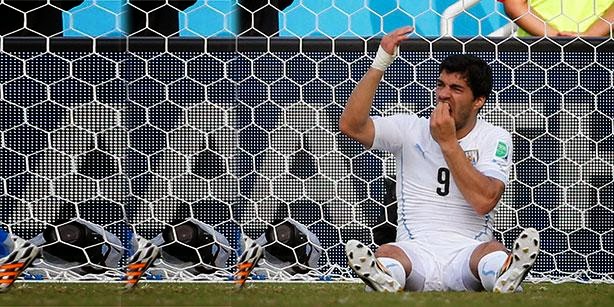 |
Football star
Andres Escobar. |
Almost 20 years ago Colombia was projected to do well in the World Cup, and was favored to beat the United States in their group stage match.
But then, in what sadly remains the best-known episode in Colombian sports, 27-year-old defender
Andres Escobar scored an
own-goal - apparently by accident - and Colombia lost 1-2 to the U.S. and made an early departure from the World Cup.
But that was only the first act of Escobar's tragedy. A popular and talented player, Escobar became the whipping boy for Colombia's disappointing performance. He returned to Medellin and hid in his house. Finally, on July 1, Escobar and a buddy went out with their girlfriends. There, the Gallón brothers, who were allegedly connected to paramilitaries and drug-traffickers, ridiculed Escobar from a nearby table.
"
Autogol, Andrés, autogol" they yelled at him.
Escobar held his temper. But after leaving the restaurant at 4 a.m. he followed the brothers' car into a
 |
| Escobar's funeral procession. |
parking lot. There, Humberto Muñoz, the brothers' driver/bodyguard, fired six bullets into Escobar's head.
Afterwards, the driver would defend his employers, claiming they hadn't ordered him to kill Escobar "yet."
Colombian President Cesar Gaviria attended Escobar's funeral. The young football star had turned from hero to goat to martyr.
Gunman Muñoz did 12 years in prison. The Gallón brothers, who had influential friends, did short prison sentences for attempting to cover up the crime. Later, however, one of them was convicted of financing paramilitary groups. (El Espectador has an
in-depth article here.)
Escobar, however, was far from the only Colombian athlete to fall victim to the country's violence.
A Cyclist's Father Murdered
 |
| Cyclist Rigoberto Duran. |
Colombian
cyclist Rigoberto Urán's second-place finish in the Giro d'Italia this month would have made headlines - if not for the fact that another Colombian, Nairo Quintana, finished first.
But Urán had to climb over more than hills to achieve cycling greatness. He also had to overcome illness, poverty and the tragedy of Colombia's armed conflict.
Born in 1987 in the municipality of Urrao, Antioquia, Urán grew up poor, helping his father collect farmers' milk and sell lottery tickets. The young Urán suffered from asthma, so to cure this his father took him cycling thru the region's hills. The boy soon improved.
However, like much of Colombia, the Urrao region was roamed by violent bands of leftist guerrillas and right-wing paramilitaries. One day, the elder Urán - also named Rigoberto - went out on a training ride and encountered an illegal paramilitary checkpoint. Altho what happened next is uncertain, the younger Urán says that the paramilitaries forced his father and others to steal cattle for them - and then killed the men.
Fatherless, the 14-year-old Urán was forced to support his family by selling lottery tickets. Nevertheless, he continued training, and soon after was signed by the Orgullo Paisa racing team. Now, he supported his family with his cycling income.
By age 18 Urán was in Colombia's national team, and a year later Team Tenax had signed him and moved him to Spain.
Kidnapping - a Professional Risk for Cycle Racers
 |
| Cyclist Luis 'Lucho' Herrera. |
Other Colombian cyclists' scrapes with their nation's armed conflict have fortunately not been so tragic.
Luis 'Lucho' Herrera was a legendary climber who achieved immortality in 1987 by winning the Vuelta a España. He retired in 1992 to spend time with his family.
However, in 2000 Herrera guerrillas kidnapped Herera. According to one report I read, only after grabbing Herrera did the guerrillas discover who they were holding. They then asked their captive to recount his racing glories, and freed him after only 24 hours, apparently embarrassed about having kidnapped a national hero.
 |
Oliverio Rincón, kidnapped
twice in one year. |
Also in 2000,
fellow cyclist Oliverio Rincón was kidnapped twice,
once together with his family, the first time by the ELN and afterward by the FARC guerrillas. The ELN held Rincón for a week, and the second kidnapping lasted for only one day. After his second kidnapping, Rincón said that the guerrillas had apologized to him.
The kidnappers "told me that I wasn't the person they were looking for, that it was a mistake and that they were very sorry about it," Rincon said.
By Mike Ceaser, of
Bogotá Bike Tours






















































